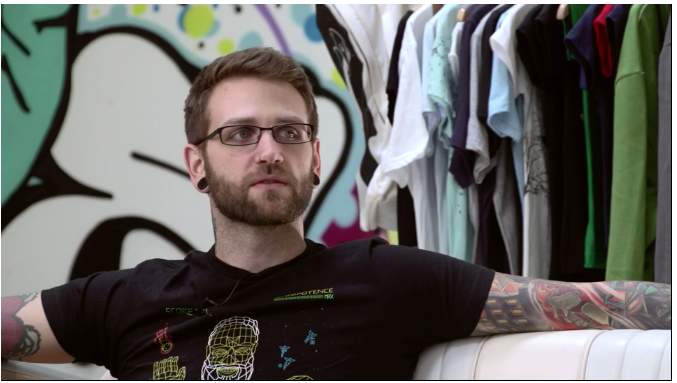
Our clients use B2B case studies a lot. We often get asked to re-write existing ones. But if we’re really, like really, honest, we don’t ever get very excited about them.
(In fact, I may even have made a finger-down-my-throat gesture once).
B2B case studies aren’t sexy. “I know! Let’s do a killer case study for these guys”, said no-one in a Velocity brainstorming, ever. We don’t think of them as on a par with the cool stuff that we share and drool over.
But why is that? When you think about it, case studies have a lot going for them. They should be fantastic for the kind of marketing we like:
- You get a chance to employ well-known businesses as a credible vehicle for your message
- They let you show how your product solved someone’s real-life pain
- You avoid the danger of overclaiming (and the naffness of dramatisation) by using a factual, proven example
- You get to use verbatim testimonials from senior people with personality
- You get to interview people with exactly the job titles you’re targeting
- You’re pretty free when it comes to format
That’s a hell of a lot of boxes ticked for lead generation. And a lot of potential for finding those kernels of authenticity that make great stories. Case studies are proto-content.
But in practice, I’ve seen few written or video case studies that don’t, almost systematically, waste their potential in one way or another. 97% of B2B case studies out there suck. No real drive, no real conviction. 3-page PDFs or talking heads with upbeat background music. Colour by numbers. No drool.
I believe the reason is that they’re a delicate format. And it’s really easy to get them wrong if you’re not careful. Here’s a few things I’ve found that would kill any good B2B case study:
When the case study is too slick.
The persuasive power of a real-life example comes from its authenticity.
Case studies are about problem-solving. That implies that you acknowledge that problems exist. If there is no chipped paint, not a single shiny face, no sentence fragments, and no weird accent in your interview, it won’t feel like a case study. It’ll feel like an investment bank’s corporate video. You don’t want that. (Especially not if you’re an investment bank.)
When everything’s just dandy, I’m not likely to believe you had a “shit-hits-the-fan” problem that made you get off your lazy ass to find a solution in the first place.
(And wouldn’t it be great if in case studies, people said things like: “Two years ago, our marketing automation was, frankly, shit. We didn’t have a clue what we were doing”. I’d read that.)
I don’t think that means a case study can’t be high production value. But spending the money on getting rid of personality is exactly the wrong way to go.
When it’s just too long and boring.
It’s probably fair to say that most case studies try to do too much. Just the basics alone usually generate more than enough copy/video length to deal with:
- Introducing the company and what it does
- The challenge/specific circumstances that made them seek a solution
- (The person who championed the solution)
- How they found your solution
- Why they chose it over a competitor’s
- And so on.
You’re already looking at a minimum of 2 tightly typed A4 pages. But none of that stuff’s interesting just because it’s true (and just because you happen to know it). You can really kill a great example when you get carried away by the wealth of real-life detail of the job titles, chronologies, and exact processes of who did what. Your audience doesn’t care. It massively inflates your copy (or video time) and bores everyone out of their skulls.
Don’t ever take your audience’s interest for granted. Every piece of information needs to earn its right to be there. And sometimes the most basic stuff isn’t that important. Here’s an example of a case study that doesn’t even reveal what their customer’s business does (they just assume everybody knows they make socks. I didn’t. But for the case study, it doesn’t matter.):
(Thanks, Harry, for pointing me to the example. It’s actually a video, but, there’s no embed code. So just click the image. Trust me.)
When it gets its wires crossed about the goals
The case study format contains a basic flaw: it’s pseudo-altruistic. There’s something inherently fake about it:
- Case studies pretend to be about your customer, but they’re really about your company and product.
- Often, they’ll present the solution of a business problem like some selfless act of kindness, while at the same time trying to cram in every feature and benefit of the solution.
As a result, the story gets all muddled, and the author will try to do a little bit of everything and please everyone. I.e. talk about the company for a while, then about the solution for a bit. The simple, basic story acquires lots of side narratives, problems become mere challenges, everyone becomes a hero. And that’s a surefire way to make content vanilla.
When it’s too low production value
This is especially true of written case studies: sometimes they’re born in the marketing department, as a side-project.
The writer of the case study never gets to meet the customer, but at some point has a ten-minute phone interview with a sales person while they’re in between meetings. They make up a “direct quote” that fits the story (or the customer emails a testimonial 3 weeks later), and then they bake all of this second-hand information into a challenge/solution/results-shaped pie. Design squeezes it into the case study template. The marketer hides the pdf somewhere on their website. Job done.
Let’s stop doing all of the above in our B2B case studies
Enough of the self-righteous ranting. I’ve got a confession to make: I can’t show you a single case study I’ve written that isn’t guilty of at least one of the above.
That’s bad. I’d love to do a case study that rocks. That means that next time we get to do one, we need to:
- Treat it like a one-off, not a compulsory exercise. That means we probably need to re-think the format (A scroll-site could be nice. Or a prezi?)
- Sit down with our client and think really hard about what we want the case study to do and get our goals straight:
- Define who it’s about: Our client or their customer? What’s our obligation to the company we’re talking about?
- Become clear on who the hero is: The senior guy who decided to buy the solution or the account manager/consultant/tech wiz who made it all happen?
- Discuss how can we talk about the problem. Since the customer has to approve it, we can’t really start out saying: “SuperSoft’s marketing director was a dull waffler who didn’t have a clue.” So we need to find another way to inject urgency. Let’s think about that properly (without dissing anyone).
- Get to the core of the story. Instead of saying it all, let’s tell a simple story, but tell it well. Where’s the kernel of truth – or the one killer fact that can be the organising principle?
Here’s an example of a B2B case study for something super-nerdy (two-factor authentication!) where they’ve done it really well. Have a look:
(Again, thank you Hazza. And again, it’s a video with no embed link – don’t these people want their case studies shared?)
It’s different, and it works – for three reasons:
- Threadless comes across as a cool company and a great place to work – but that doesn’t take up too much time, or distract from Duo’s story.
- The interviewee is authentic. He knows his stuff, and he talks credibly about his frustration, using his own words.
- He’s not claiming Duo solved all his problems – but that it solved that one problem really well.
Let’s do them like that.

Enjoyed this article?
Take part in the discussion










Comments
Harendra Kapur November 23rd, 2015
Such a great post. And such an important subject.
Case studies are crucial, especially when marketing to pragmatists in the early stages of category and market building (classic B2B paradox there…). But way too often the budget/interest allotment doesn’t match the potential of the format.
AND from a writing POV, great time to flex our journo muscles.
PS. I most certainly HAVE said the words “let’s do a really cool case study for them” in multiple brainstorms. I just haven’t pushed a whole lot harder after…so shame right back on me.
Irene Triendl November 23rd, 2015
Thanks Har. Stan mentioned another case study peeve: when the customer is all over the moon over how great the product/everyone at the company is. He was like “They’re already endorsing you. Don’t also make them sing your praises.”
Brittany Sykes July 12th, 2016
What are your thoughts on case studies where one can’t mention the name of the company that it’s helped/currently helping?
Doug Kessler July 16th, 2016
Hi Brittany. These are still worth doing. Clearly, it’s far better to be able to name the company and get their participation. But if you can’t do that, it’s a shame to kill a great case story!
Colman Xerox December 3rd, 2016
You had me at “Opt into our crap.” Your thank you is too precious for words. Unless BwaaaHaaaaaHaaaaa is a word. Is it?
Doug Kessler December 8th, 2016
I think it counts — thanks!
Sanika dravidian Market.Biz September 4th, 2017
Yes, case studies are some times the useless thing, it really sucks, especially when you get anything out of it.